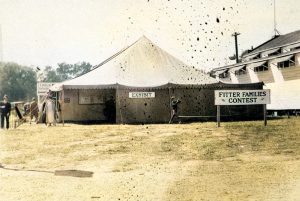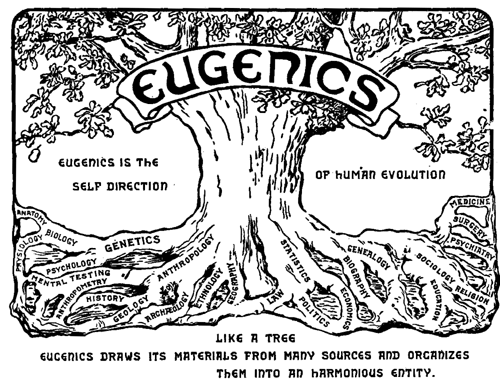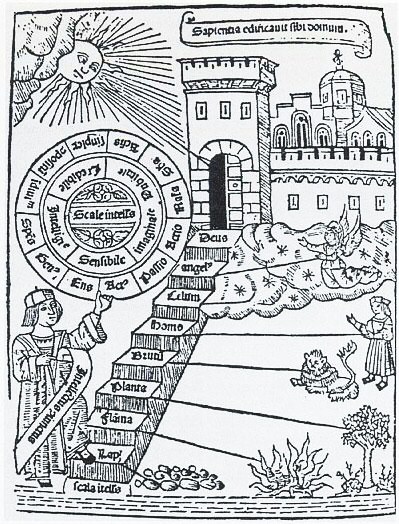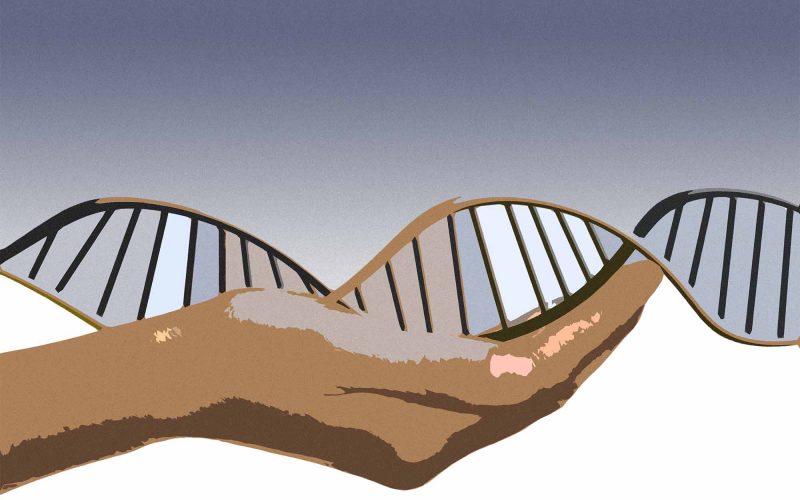The influence of eugenics on Frank Herbert’s Dune emerges most clearly in the Bene Gesserit’s philosophy and breeding program, but is also visible in Paul Atreides’ concern with his terrible purpose. Ideas in the book about competition and survival, human vs. animal, and stagnation and the gene pool link with ideas from the eugenics movement about how humanity might improve itself.
Overview of Eugenics
Eugenics is a loaded term with associations to some of the darkest parts of 20th-century history. Some would like to believe that it faded away after WWII. But this is a myth that distorts the way it was repackaged away from a focus on race or mass sterilization programs and toward individual choice and genetic counselling, according to Alexandra Minna Stern’s Eugenic Nation: Faults and Frontiers of Better Breeding in Modern America. [1] Stern’s book provides a detailed history of eugenics in the U.S., including its overlooked impact on the West Coast, where it extended to nature conservation. If “California stood at the vanguard of the national eugenics movement” in the late 19th and early 20th century, it is likely that eugenicists’ ideas, polices, and practices would have had an influence on the environment in which Herbert lived much of his life. [1]
The term eugenics was coined in 1883 by a cousin of Charles Darwin, Sir Francis Galton, who defined it as “the science which deals with all influences that improve the inborn qualities of a race; also with those that develop them to the utmost advantage”. [1] Essentially, it refers to “better breeding”; the controversy is about what does ‘better’ mean, who gets to decide and enforce their preferences about what is ‘better’, and how does this play out in reality. [1] Eugenics offered a kind of umbrella to the various pseudo-sciences and reform movements of the late 19th and early-mid 20th century, including “purity reform, health reform, sex hygiene, radical sex reform, marriage counseling, antivice campaigns, ‘fitter family’ contests, the child-rearing advice industry, and, eventually, the birth control movement”. [2]

Its goal was to improve humanity both “by encouraging breeding of those presumed to have desirable genes (positive eugenics), and discouraging breeding of those presumed to have undesirable genes (negative eugenics)”. [3]

Eugenics emerged in part as a response to Darwin’s theory of evolution, which challenged how humans in certain cultures viewed themselves within the natural world. The previous view of nature in Christianity was the Chain of Being, with God on top, then angels, then humans, then the animals, plants, and minerals of the natural world (see image).

In this view, humans had a special, unique place in the hierarchy of life. But if humans were just another species—closer to animals than previously thought—it was thought that they could slide back into a more primitive state of nature. This fear of degeneration, among other concerns, motivated some reformers to want to improve the human genetic stock. They believed if they could encourage positive traits to be passed on, they could steer humanity clear of the pitfalls of genetic problems as well as moral decay. We will see this in some of the motivation for the Bene Gesserit’s breeding program.
There was also an element of survival of the fittest. With growing populations, immigration flows, and movement of people from agricultural lands to the cities, there was competition for housing, jobs, and resources. Class and racial struggles pitted people against each other. Reformers sought a remedy to the ills of modern societies, including “pauperism, crime, disease, prostitution, alcoholism” and urbanization. [2] By the late 19th century in the U.S., there were fears about the future of the American family amid a decline in birthrates and a rise in divorce rates. [2]
Many of these themes made their way into science fiction—a genre focused on the changes science and technology were creating in the world. Sometimes it was subtle; other times, more obvious. For example, Aldous Huxley, the brother of eugenics proponent Julian Huxley, wrote Brave New World (1932) as a dystopian novel that showed a possible future where humans were created in labs and had their growth stunted based on the type of job they were destined to perform. [4] In recent times, examples of real-life eugenics-type activities include population control at the state level (e.g., one-child policies, forced sterilization, pro-birth campaigns) and at the individual or family level (e.g., sex-selective abortions, designer babies).
Bene Gesserit Breeding Program
In Dune, the Bene Geserit’s breeding program is a more obvious example of a eugenics project. The Bene Gesserit’s name even has similarities to the term eugenics, which comes from the Greek eu (good or well) and gens (to produce), the root of genesis (to come into being, be born). [1] [5] Bene Gesserit comes from the Latin bene (well, rightly) and gesserit (she/he/it will have born), derived from a third-person form of the verb gerō (to bear, carry, carry in the womb). [6] [7] While Timothy O’Reilly takes this combination to mean “it will have been well borne” [8], I prefer to keep the feminine pronoun and read it as either ‘she will have born well’ or something more broad such as ‘she who bears well’ or ‘she who has good bearing’. Since it is the name of the order as well as a description of individual members, it could also be read as a general ‘good bearers’, which can imply both that these women are mothers and that they are bearers of other things, such as information and religion. The latter ties in with their connection to the Jesuits, which the word Gesserit sounds like, a topic to be explored in another article.
It is significant that it is women in charge of reproduction. Historically, activities such as midwifery and birth control planning were taken over by the male medical profession, and part of the 1960s and 70s women’s movement aimed to reclaim women’s right to be knowledgeable about and in control of their own reproductive bodies. [1] In a world where women have been and continue to be sterilized against their will by the state, or prevented from accessing birth control or sterilization procedures when they are wanted, the image of an all-women organization in control of a breeding program is noteworthy.
We learn of the breeding program early on through one of the book’s key characters, Lady Jessica. She is part of this program and has disobeyed her orders to bear a daughter, throwing a wrench in the plans. Reverend Mother Mohiam discusses with Jessica the reason for their careful attention to directing human evolution via the breeding program:
“You well know the pattern of our affairs, Jessica. The race knows its own mortality and fears stagnation of its heredity. It’s in the bloodstream — the urge to mingle genetic strains without plan. The Imperium, the CHOAM Company, all the Great Houses, they are but bits of flotsam in the path of the flood.” [9]
Mohiam does not presume to be able to completely control the outcome of this urge, but she says that they hope to “prevent this from erupting into general conflagration, to salvage what we can of the key bloodlines.” [9] The language of ‘mortality’, ‘fears’, ‘stagnation’ and ‘flood’ creates a sense of dread toward events of the future and connects with ideas from eugenics about the human race devolving.
The Bene Gesserit’s secret breeding program has been running for ninety generations and its goals are multifold. First, the Bene Gesserit want to have a hand in the Imperium’s politics and can do so by arranging alliances and giving certain childbearing instructions to women who are concubines and spouses to ruling men. Baron Harkonnen’s Mentat, Piter de Vries, notes that “these Bene Gesserit bear mostly daughters”. [9] This means the Sisterhood can not only maintain a steady influx of young woman for its education and training program, but also strategize over if and when male heirs will be born. For instance, in the case of the Emperor, his spouse has four daughters, leaving him without a clear successor. Jessica’s decision to bear a son means that in this medieval-type universe, her family is in a better position to succeed to the imperial line.
Second, the Bene Gesserit hope to improve the ‘stock’ of humanity and prevent humans from allowing themselves to be enslaved by machines again. Mohiam says the “original Bene Gesserit school was directed by those who saw the need of a thread of continuity in human affairs. They saw there could be no such continuity without separating human stock from animal stock—for breeding purposes”. [9] It is only by choosing the best humans to reproduce and testing them that the Bene Gesserit can ensure they keep a hold on humanity and prevent it from following the path of sliding backward or falling into enslavement. The test of humanness that the Bene Gesserit administer reflects this kind of survival-of-the-fittest mentality and a disdain for instinctive, animal-like behavior. In essence, they want society to be populated by humans who do not let themselves be ruled by animal instincts. They value intelligence and control of the mind and body.
Third, the Bene Gesserit seek to create a superhuman specimen known as the Kwisatz Haderach, the “one who could be many places at once”. [9] With this male Bene Gesserit, they could wield his prescient abilities as a tool and thereby hold power indirectly at a safer distance. Part of Jessica’s motivation to have a son was to produce this long-awaited figure, but this means he has come a generation too early. Paul is trained as a Mentat and a Bene Gesserit and has prescient dreams even before moving to Dune, then fully comes into his abilities when on the spice-rich planet. But in part because he is away from the Bene Gesserit’s influence while among the Fremen, he avoids becoming a tool for the Sisterhood and rejects their authority over him. His outburst at Mohiam at the end of the novel exposes the secretive breeding program to the Emperor and his entourage and reminds us that even the best-laid plans for offspring can go astray:
“This is a Bene Gesserit Reverend Mother, patient in a patient cause. She could wait with her sisters — ninety generations for the proper combination of genes and environment to produce the one person their schemes required. Observe her! She knows now that the ninety generations have produced that person. Here I stand … but … I … will … never … do … her … bidding!” [9]
However, Paul never can free himself from the gift/curse of prescience that his breeding enabled, so his boast becomes increasingly hollow in the sequel.
Human Race Consciousness
Sitting alongside the breeding program is the idea of humanity as an organism that needs to evolve and adapt to survive, to avoid slipping into stagnation. This idea emerges when Paul is considering his “terrible purpose”, and the term ‘race consciousness’ appears several times:
“He remained silent, thinking like the seed he was, thinking with the race consciousness he had first experienced as terrible purpose.”
“He felt himself touched briefly by his powers of prescience, seeing himself infected by the wild race consciousness that was moving the human universe toward chaos.”
“But he could feel the demanding race consciousness within him, his own terrible purpose…”
“Terrible purpose remained. Race consciousness remained.” [9]
The implication is that humankind somehow knows it needs a shake-up, something to force the genes to mingle so that “strong new mixtures” can survive. [9] The factions, including the Bene Gesserit, the Harkonnens, and the Emperor, are caught in “the need of their race to renew its scattered inheritance, to cross and mingle and infuse their bloodlines in a great new pooling of genes”. [9] Paul believes that this will no longer happen gradually though. Instead, it will come to be via the jihad, the “only one sure way for this” to happen. [9] It is a “juggernaut..gathering weight and momentum”. [9] It is “wild…moving the human universe toward chaos”. [9] By the end of the novel, Paul realizes it is futile to resist or try to change this future:
“The race of humans had felt its own dormancy, sensed itself grown stale and knew now only the need to experience turmoil in which the genes would mingle and the strong new mixtures survive.” [9]
Words such as ‘dormancy’ and ‘stale’ link with the idea in eugenics that humans may have stopped developing and progressing. Without new pairings, the human race will presumably stagnate or even fall backwards. The solution presented is ‘turmoil’ through conflict that will see only the strong survive.
If the jihad is the way to strengthen the human race, though, the Dune series remains vague about many of the implications of this mechanism. For instance, will the genetic mixing occur through consensual means, or wartime assault? But we should note the significance of having the cultural group marked as being derived from Arab and Bedouin peoples (with influence from other populations such as Native Americans), and being indigenous to Dune, to be the ones to initiate this process. On the one hand, it can be argued that this perpetuates an association with violence and uncivil behavior and a stereotype of such peoples as wild and uncontrollable. On the other hand, this process is something that factions believe is needed and desirable, and it is the Fremen, coded as the indigenous people overthrowing their oppressors, who will see it through. There is a foreigner, Paul, facilitating the process, but he cannot control what happens when they leave the planet. The Fremen are the ones who will dispense their genes and strengthen the human race. This is something that would benefit from further exploration and comparison to other works of science fiction. There is also the matter of the Tleilaxu faction and their take on breeding and genetics, which is quite different from that of the Bene Gesserit – to be explored in the future!
References:
[1] Stern, Alexandra Minna. Eugenic Nation: Faults and Frontiers of Better Breeding in Modern America. University of California Press, 2015.
[2] Rosen, Christine. Preaching Eugenics: Religious Leaders and the American Eugenics Movement. Oxford University Press, 2004. Pages 7, 10-11.
[3] King, Robert C., Pamela K. Mulligan, and William D. Stansfield. “Eugenics.” A Dictionary of Genetics. 8th edition. Oxford University Press, 2014.
[4] Weindling, Paul. “Julian Huxley and the Continuity of Eugenics in Twentieth-century Britain.” Journal of Modern European History, vol. 10, no. 4, 2012, pp. 480-499. doi: 10.17104/1611-8944_2012_4
[5] Scott, John. “Eugenics.” A Dictionary of Sociology. 4th edition. Oxford University Press, 2014.
[6] Kennedy, K. “Epic World-Building: Names and Cultures in Dune.” Names, vol. 64, no. 2, 2016, pp. 99-108. doi: 10.1080/00277738.2016.1159450
[7] Kennedy, K. “Names in Dune: Origins and Meanings.” YouTube, uploaded by Dune Scholar, 30 July 2020.
[8] O’Reilly, Timothy. Frank Herbert. 1981. Page 54.
[9] Herbert, Frank. Dune. 1965. Reprint Berkley Books, 1984. Pages 9, 12, 17, 23-24, 119, 164, 199, 219-220, 317-318, 386, 444, 482.
Image Credits:


